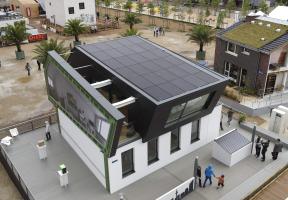What Is Meant by Degrowth?
Published on 03.16.202110 min read

Patrick Criqui
What Is Meant by Degrowth?
Numerous debates have sprung up in France and around the world about the role of economic growth in our societies and whether or not it should be reduced in order to preserve the planet and mitigate climate change. Patrick Criqui, a modeling and scenario planning expert, explains the challenges.
In the debate on degrowth, we need to be clear about what we’re talking about. If the idea is to transition away from activities that consume large amounts of natural resources and energy sources that produce vast quantities of greenhouse gas, then yes, degrowth is absolutely necessary to keep a lid on . Reducing these activities is therefore critical, there’s no way of getting around it.
The debate, however, usually centers on degrowth in gross domestic product (GDP). GDP is an economic indicator that measures the value of all goods and services produced within a country in a given year. During the last several decades, the most advanced industrial nations have registered weak or sluggish growth. Whereas today a growth rate of 2% is considered satisfactory, in the 1960s it would have signaled a serious crisis. Emerging markets are growing faster, but as they develop and catch up with “advanced” economies, the rate of growth tends to slow, as it did in China.
Growth critics claim that governments are obsessed with annual GDP and are ready to sacrifice environmental concerns for economic growth. But there is another consideration that government leaders take, or should take, into account and that is providing enough suitable employment opportunities to ensure the well-being and social stability of their countries.
The problem is that providing decent jobs is more difficult during an economic slowdown. Unemployment rises, job quality drops. In a scenario of zero or negative growth, it’s hard to see how social stability could be maintained. For degrowth proponents, the answer is to redistribute wealth. Although this is theoretically possible, in practice it’s much more difficult and could lead to serious conflict.
Possible Solutions
How do we reconcile the twin objectives of providing enough decent jobs and protecting the environment? There are a few ways of going about it:
- Align GDP goals with both environmental and employment needs. To do so, it will be necessary to create a new macroeconomic balance: less consumption of polluting products (i.e., that emit CO2) and more investment in sustainable innovations, carbon-neutral products, circular economy processes, etc. Why invest more? Simply because doing things “cleanly” is harder than doing them in a way that causes damage to natural resources and the environment.
- Develop new technologies that make these sustainable transitions possible, without killing skilled jobs in the services sector. Too many discussions on this topic are focused on the following theme: “Do we tackle environmental problems through technological innovation or through behavior change?” What poses a problem here is the word “OR”? The challenges are such that both are necessary. We need behavior change AND technological innovation.
- Ensure effective policy coordination at all levels of governance. In other words, everyone is responsible. Action is required at different levels – international, geographical bloc (Europe), country and region – including at the decentralized level of companies and citizens.
Lastly, although globalization has had certain negative impacts, it can’t be ignored that one billion people have been lifted out of extreme poverty over the past 30 years. Many environmental groups blame globalization and world trade for ecological imbalances. Their demands include deglobalization, industrial repatriation and a renewed focus on regions. Although it’s always a good thing to rely on local resources, that doesn’t mean that global trade, innovation and new technology are all bad. To the contrary, these things, along with global cooperation, are vital to the transition to environmental .
Patrick Criqui is Emeritus Research Director at the French National Center for Scientific Research (CNRS) and the Grenoble Applied Economics Lab (GAEL). His work focuses on sustainable innovation and consumption, especially in the energy and agro-industrial sectors. He was a member of the working group on mitigation at the , and he is currently a member of the Economic Council for at the French Ministry for the Ecological and Inclusive Transition.

Gilbert Cette
Carbon Intensity, the Key to Future Growth
The “carbon content” of the products we make and consume is an issue the growth debate can’t ignore. Economist Gilbert Cette explains how improving this metric could prevent a degrowth scenario in which the world would slip into an intolerable decline.
There are two ways of winning the climate battle, in other words, achieving carbon neutrality or net zero greenhouse gas emissions by the middle of the century.
The first is based on the logic of degrowth: produce less and less until we attain zero net emissions. I will explain later how this would be a return to the Stone Age.
The second approach is to reduce the carbon intensity of the economy. What does that mean? The production of goods and services to sustain our livelihood requires the use of energy, and most energy sources produce CO2 emissions, and therefore carbon. The carbon content of production varies in size depending on the country. Over the past 50 years, developing countries have greatly reduced their carbon intensity, thanks to technology and the combined efforts of governments, companies, regions and consumers. Today, it is decreasing by about 1.5% every year, compared to economic growth of around 3% to 4% prior to the COVID-19 crisis. What we need is to lower the carbon content of gross domestic product (GDP) by 5% to 10%. This is something entirely different from reducing GDP itself.
How Do We Do It?
The main driver is research and innovation to develop , renewable energies and new technologies for limiting and capturing CO2. Research needs to be given greater visibility to enhance willingness and motivation within the industry and offer the reassurance of profitable solutions. Look at COVID-19 research. A year ago, no one believed it, but the pressure was so intense and the financial stakes so high that several vaccines were developed, including some revolutionary ones. The world witnessed a similar phenomenon when the United States, in its determination to catch up with the Soviet Union’s space program, announced it would send a man to the moon in ten years. In the absence of credible targets, no one will want to take the risk of investing heavily in research. Tailoring research to energy transition issues would also require schools and universities to adapt their programs.
Another important field of action is pricing, which would involve taxing the carbon content of every good or service produced or consumed in a progressive, fairly rapid, continuous manner over the long term. This requires setting a price per ton of carbon. The greater a product’s emissions, the higher its price signal, which could act as a disincentive for those who make or buy it. For this type of policy to work, however, it needs buy-in from all sides. If there is no coordination, countries that don’t adopt it will have a competitive advantage over those that do.
At the country level, care must be taken to ensure that the tax increases don’t penalize a given segment of the population. The “yellow vest” movement in France showed how sensitive public opinion could be. The revenue from a carbon tax should be used primarily for redistribution policies aimed at attenuating the impact on the most vulnerable people.
Saving for the Future
The implementation of these policies will be long and complex. The taxation of carbon emissions, for example, will necessarily slow down growth in the short to medium term. Production techniques will all need to be realigned, which could result in lower productivity. The transition will pay off, but only in the very long term.
In any event, this approach is preferable to outright degrowth, which can only be a recipe for failure. It is clear from the pandemic that no one wants to see a return to the healthcare conditions of a few centuries ago. Moreover, in a context of zero or negative growth, is anyone in developed or emerging markets ready to return to past living standards?
The message needs to be passed that if we must reduce consumption or invest in new techniques, it’s to save for the future. It’s kind of like when you insulate your home: it’s an investment that pays off in the long term.
Gilbert Cette is an Associate Professor of Economics at the Economic Sciences department of Aix-Marseille University. A specialist in labor market trends, work time and productivity, he has co-authored the book “Le Bel Avenir de la Croissance” (Editions Odile Jacob), alongside Antonin Bergeaud and Rémy Lecat.



















